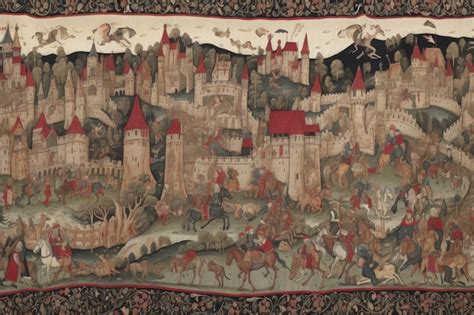Introduction
The medieval period, spanning from the 5th to the 15th centuries, was a transformative era that witnessed dramatic social, political, and technological advancements. This presentation aims to transport you back in time to explore the complexities and splendors of this captivating epoch.

Rise of Christianity and the Crusades
The spread of Christianity played a pivotal role in shaping medieval society. By the 10th century, it had become the dominant religion in Europe. This religious fervor fueled the Crusades, a series of military expeditions launched by Western Christian armies to regain control of the Holy Land from Muslim rule.
Crusade Statistics:
| Crusade | Dates | Number of Participants |
|---|---|---|
| First Crusade | 1095-1099 | 100,000 – 200,000 |
| Second Crusade | 1147-1149 | 50,000 – 100,000 |
| Third Crusade | 1189-1192 | 100,000 – 200,000 |
| Fourth Crusade | 1202-1204 | 20,000 – 40,000 |
Feudalism and the Chivalric Code
Feudalism, a socio-political system based on land ownership and military service, emerged as the dominant organizational structure during the medieval period. Knights played a central role in this system, adhering to a strict code of conduct known as chivalry.
Key Principles of Chivalry:
- Loyalty and service to one’s lord
- Bravery and courage in battle
- Courtesy and respect towards women
- Justice and fair play
Urbanization and the Rise of Trade
The medieval period witnessed a significant increase in urbanization. Cities became centers of commerce and trade, leading to the development of guilds, which regulated crafts and professions. This economic growth fueled the rise of a middle class and sparked innovation.
Merchant Guild Statistics:
| City | Number of Guilds |
|---|---|
| London | 80 |
| Paris | 100 |
| Bruges | 60 |
Gothic Architecture and Artistic Innovations
Medieval Europe witnessed the emergence of stunning architectural styles, particularly the Gothic. Characterized by pointed arches, ribbed vaults, and intricate stained glass windows, Gothic cathedrals symbolized the ingenuity and artistic splendor of the era.
Gothic Architecture Statistics:
| Cathedral | Construction Dates | Height (m) |
|---|---|---|
| Notre Dame de Paris | 1163-1345 | 90 |
| Amiens Cathedral | 1220-1288 | 112 |
| Cologne Cathedral | 1248-1437 | 157 |
The Black Death and its Impact
In the mid-14th century, Europe was ravaged by the Black Death, a devastating plague that killed an estimated 30-60% of the population. This catastrophic event profoundly impacted medieval society, leading to social unrest, economic decline, and a decline in population.
Black Death Statistics:
| Region | Mortality Rate |
|---|---|
| Asia | 50-60% |
| Europe | 30-40% |
| North Africa | 30-40% |
Medieval Education and Universities
Education played a vital role in medieval society. During this period, universities emerged as centers of knowledge and scholarship. Students flocked to these institutions to study theology, law, medicine, and the arts.
University Statistics:
| University | Foundation Year | Number of Students |
|---|---|---|
| University of Paris | 1150 | 20,000 |
| University of Bologna | 1088 | 10,000 |
| University of Oxford | 1096 | 3,000 |
Scientific Advancements and Technological Innovations
The medieval period also witnessed significant scientific and technological advancements. Arabs made invaluable contributions to astronomy, mathematics, and medicine. In Europe, the invention of gunpowder and the printing press revolutionized warfare and communication.
Medieval Scientific Discoveries:
| Discovery | Scientist | Year |
|---|---|---|
| Earth is round | Eratosthenes | 2nd century BC |
| Laws of Motion | Aristotle | 4th century BC |
| Astrolabe | Hipparchus | 2nd century BC |
| Compass | Chinese | 10th century |
The Renaissance and the End of the Medieval Period
By the 15th century, Europe was on the cusp of a new era. The Renaissance, a period of cultural and intellectual rebirth, marked the transition from the medieval to the modern world. Humanism and the rediscovery of classical texts ignited a renewed interest in art, literature, and science.
Conclusion
The medieval period was a complex and multifaceted era that laid the foundation for Western civilization. Its religious fervor, feudal structure, urbanization, architectural wonders, and scientific advancements continue to captivate scholars and historians to this day. As we reflect upon this fascinating chapter in human history, we can appreciate its profound impact on shaping the world we live in today.
